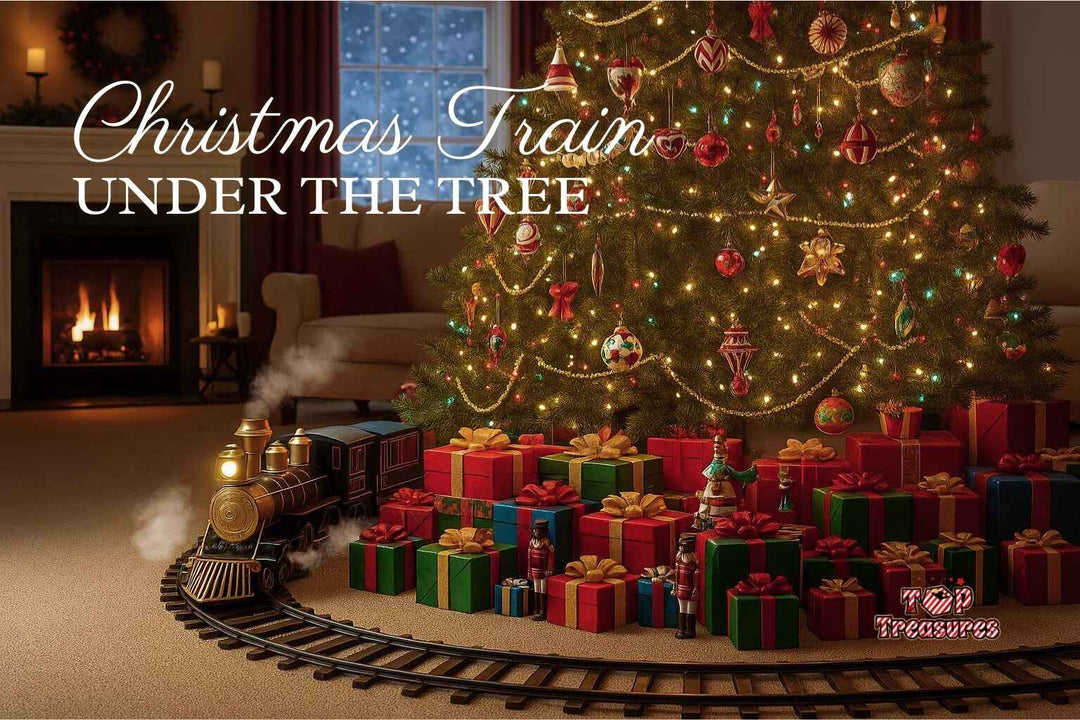The History of Christmas Village Displays
For many, the unboxing of a Christmas village is a treasured ritual, a signal that the holidays have truly begun. These miniature glowing worlds are far more than just decorations, they are symbols of family and tiny vessels for a lifetime of memories. The act of arranging each porcelain shop and ceramic house is often an act of rebuilding those memories, piece by piece.
The rich history of Christmas village displays reveals a fascinating journey, tracing a line from humble handmade religious dioramas in 18th-century Europe to the elaborate, animated, and cherished porcelain heirlooms that grace our mantles today. This tradition has evolved remarkably, transforming from a simple craft of paper and moss into a multi-million dollar "villaging" hobby. This demonstrates that even the smallest traditions can house the grandest magic.
Where Christmas Villages Began
To find the origin of Christmas village decorations we must look back centuries. The tradition's roots lie in the nativity scenes, or crèches, that spread across Europe during the Renaissance. But the most direct ancestor of the village we know today is a unique tradition known as the Moravian "putz".
The Nativity and the "Putz"
In the 18th century, Moravian immigrants from Saxony, Germany, brought this cherished custom to their new settlements in America, most notably Bethlehem, Pennsylvania. The name "putz" is derived from the German verb putzen, which means "to decorate" or "to clean".
A critical distinction must be made: a crèche is typically a single scene of the manger, but a Moravian putz was a sprawling narrative diorama. It was, in effect, "the Gospel in miniature". These elaborate displays were designed to tell the entire Christmas story, often beginning with Isaiah's prophecy and moving through the Annunciation, the journey to Bethlehem, the adoring shepherds, the manger scene (which was always the center ), the visit of the wise men, and the flight into Egypt.
These were not static silent displays. The Moravian church, unlike many other Protestant denominations of the time, embraced religious art as a vital part of faith. The putz was an early form of immersive multimedia storytelling. Historical accounts and surviving examples like the famous putz built by folk artist Jennie Trein starting in 1908, were complete with "lights, sound effects, and narration". Families would engage in the custom of "going putzing", which meant visiting other homes to see and hear the story unfold as tiny lights illuminated each scene. This 18th-century desire to use technology and narration to create magic is the clear forerunner of today's animated, musical villages.

From Moss and Twigs to Town Squares
The craftsmanship of the early putz was deeply personal. The displays were handmade using natural materials foraged from the local landscape. Many of the figures were antique German carvings of wood, wax, and clay, and were nestled amidst live moss, driftwood and rocks to create a realistic landscape.
However, as the 19th century progressed, a crucial shift occurred in the Christmas village history. A dual identity began to emerge in Moravian homes. Families continued to build the traditional sacred putz, but they also began constructing secular displays as a holiday treat for children.
These new displays featured miniature townscapes, charming houses, and most importantly, wind-up toy trains that would circle under the Christmas tree. As one Moravian minister noted in 1907, a "genuine putz should be... played with". This separation of the sacred (the manger story) from the secular (the town-and-train) was a pivotal moment. It created a new non-religious category of holiday display focused on an idealized town, which is precisely what allowed the tradition to be commercialized and adopted by the secular mainstream.

How Miniature Christmas Villages Became a Beloved American Tradition
The tradition's leap from a niche religious custom to a widespread American phenomenon was fueled by mass production, new technology, and a brilliant stroke of marketing.
The "Dime Store" Sparkle
The key figure in this transition was F.W. Woolworth. In the late 19th and early 20th centuries, his "dime stores" popularized imported German-made decorations. When World War I disrupted this supply chain, Woolworth and other retailers turned to Japanese manufacturers.
This new wave of "putz houses" was made from a new, inexpensive material: cardboard. But the "real revolution," as collectors call it, happened around 1928. Before this, many cardboard houses were simply festive candy boxes. Around 1928, affordable electric C-6 light strands became a common household item. Japanese manufacturers immediately adapted, punching a hole in the back of the houses. This simple innovation was transformative. For the first time, families could poke a single bulb from their Christmas lights through the back, illuminating the colorful cellophane windows from within.
This was the tradition's first symbiotic relationship with technology. The electric light bulb is what created the magical, glowing village. These charming "Made in Japan" glitter houses, often selling for just five or ten cents, became a staple of the American holiday, lining mantels and filling the space under trees through the 1930s and 1940s.

Department 56
After World War II, the hobby dwindled. Tastes changed and the television set became the new glowing centerpiece of the American living room, leaving less space for elaborate displays. This created a nostalgia gap that the generation grew up with the magical disposable cardboard houses as adults.
The tradition was reborn in 1976 from a moment of pure nostalgic magic. As the story goes, a group of friends, including founder Ed Bazinet, was driving through the quiet river town of Stillwater, Minnesota, on a snowy night. They were captivated by the small, old-fashioned village decorated for the holidays with lights sparkling on the freshly fallen snow.
That spark of an idea led Bazinet, whose wholesale gift import division at a Minneapolis florist was known by its accounting number "Department 56" to create something new. In 1976, Department 56 introduced The Original Snow Village, a series of six hand-painted ceramic Christmas villages.

The Rise of Lemax
For over a decade, Department 56 dominated this new premium market. Then, in 1990, a competitor emerged. Lemax entered the market by offering beautiful and intricate porcelain buildings at a more accessible price point, directly competing with Department 56.
This created a healthy market bifurcation. As collectors often note Department 56 was seen as the high-end and premium brand, with crisper paint lines and more intricate detail, but it often came at double the price. Lemax on the other hand, democratized the hobby. Its key differentiator was not just price, but the animation. Lemax leaned into miniature model fairground rides and pieces with more effects and more visual interest.
This Premium vs. Pop dynamic was ultimately a benefit for all village collectors.

The Meaning Behind the Magic
What is a Christmas village display on a deeper and psychological level? Why do these miniature worlds hold such power over us? The answer lies in a combination of psychology, nostalgia, and the human need for legacy.
Building an Idealized World
At its heart, building a village is an act of creation. Psychologists refer to the power of miniatures as "symbolic mastery" and having the ability to create and hold a world in your hand. In a holiday season that often feels rushed and loud, the Christmas village is a peaceful miniature world, and the collector becomes a benevolent creator, a city planner for a perfect, idealized community.

Tangible Nostalgia and Family Legacy
This is the emotional core that answers why people collect Christmas villages. More than anything, the collection serves as a tangible anchor for warm memories of childhood and family.
The meaning of Christmas village becomes deeply personal. Collectors often acquire pieces to mark personal milestones, creating a physical map of their lives. The bakery that reminded them of Grandma, or the little church that looked just like the one they were married in.
This reveals the dual power of a Christmas village collection. It is simultaneously a physical scrapbook of the collector's past and a future legacy for their family. This act of legacy building connects the collector's own cherished memories to the joy of the present and the family who will inherit the tradition, weaving a thread of continuity through generations.

Modern-Day Christmas Villages and Its Evolving Traditions
The modern village collector has more choices, more technology, and more ways to connect than ever before.
Licensed Themes
The most significant modern trend is the explosion of licensed themes. The "idealized world" is no longer limited to Victorian England or 1950s Main Street, USA. For a new generation of collectors the most powerful nostalgia is tied to pop culture.
The "Harry Potter Christmas Village" is a prime example. Both Department 56 and The Bradford Exchange have created unbelievably lifelike collections crafted using the exact specifications from the movie studio. Fans can build their own miniature world featuring Hogwarts Castle, Ollivanders Wand Shop and Hogsmeade. These licensed worlds, which also include The Grinch, Disney, National Lampoon's Christmas Vacation, and even Ghostbusters, are the single most important gateway for attracting younger millennial collectors for whom Hogwarts is the ultimate nostalgic Christmas touchstone.

The "Villaging" Community and High-Tech Displays
The act of "villaging" has also become a shared public passion. A vibrant community of collectors shares christmas village display ideas and showcases their work on social media platforms like TikTok, Instagram, and Reddit, in forums like r/Villaging and r/LEGOWinterVillage.
This has, in some circles, transformed the private hobby into a public performance, driving a maximalist trend. Collectors now build for their followers, creating elaborate Instagram-worthy displays using risers for height, faux snow blankets, and forests of bottle brush trees. This is supported by modern technology, including bright LED lighting, complex animated pieces, and even DIY programmable RGB light shows.
The Minimalist Village
As a direct counterpoint to this more is more approach, a cozy minimalist or Scandinavian trend has emerged. This aesthetic favors a clean all-white palette. It is often a DIY project where mismatched thrift-store houses are unified with white spray paint.
For this collector, the goal is not to amass a large collection or spend hours "putzing." The goal is to create a simple, elegant design element, perhaps contained in a single glass lantern or on a wooden tray, accented with delicate copper-wire lights. This trend shows the tradition's remarkable flexibility that is able to serve both the maximalist storyteller and the minimalist designer.

From the humble Moravian putz to the sprawling, animated displays of today, the history of Christmas villages is a story of family, memory, and magic. Whether you're a maximalist builder with a love for licensed themes or a minimalist looking for that one perfect piece, the tradition is what you make it.
At Top Treasures, we're passionate about helping you build your own magical world. Explore our curated collection of village pieces, from timeless heirlooms to modern animated wonders, and start building your own family legacy today.





LEAVE A COMMENT